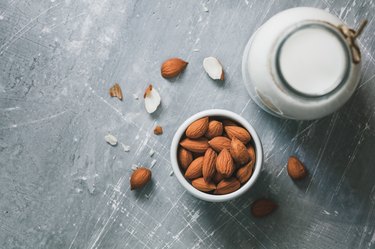
Complete protein foods provide adequate amounts of all nine essential amino acids — those that your body can't make and must instead get from your diet. If you eat a vegetarian or vegan diet, it's important to aim for variety each day, so your body can get enough essential amino acids.
Tip
If you eat a plant-based diet, many foods in your diet are probably not complete protein foods. However, if you’re eating foods like soy or quinoa, or you’re combining foods like grains and nuts throughout the day, you should be getting all of the essential amino acids your body needs.
Video of the Day
The Essential Amino Acids
MedlinePlus notes that there are 20 different amino acids that your body uses like building blocks, to assemble into proteins. Proteins are necessary for building muscles, tissues and organs. Proteins are also used to make antibodies, enzymes and chemical messengers, all of which help your body run well and stay healthy
Video of the Day
Your body has the ability to make all but nine of the amino acids. These nine are called "essential amino acids" because it's essential that you get them from your diet. They are:
- Histidine
- Isoleucine
- Leucine
- Lysine
- Methionine
- Phenylalanine
- Threonine
- Tryptophan
- Valine
All animal-based foods are high in protein, and they're also considered complete protein foods. This means that they provide ample amounts of all nine of the essential amino acids. Complete protein examples include meats, poultry, fish, dairy foods and eggs.
Read more: 7-Day Protein Diet
Even if you eat a mostly vegetarian diet, combining your meals with just a small amount of any animal foods, like eggs, cheese or fish, makes it very easy to get adequate amounts of complete protein in your diet.
The Proteins in Plant Foods
Plant foods also provide plenty of protein, but in most cases, their protein is considered "incomplete" because it's lacking, or low in, one or more of the essential amino acids. There are very few complete protein examples of plant-based foods, and these include quinoa and soybeans.
Combining some quinoa and a few soy-based foods with the rest of your diet every day is another easy way to get enough complete protein foods. Soy-based foods that are complete protein examples include tofu, tempeh, edamame, soy nuts and soy milk.
Although it's best to eat whole soy foods like these, vegetarian options that include soy as an ingredient, like many veggie burgers, sausages and other "fake meat" products, can also provide a source of complete protein.
Read more: What Amino Acids Do Vegans Tend to Lack?
All other plant foods, including vegetables, grains, legumes, nuts and seeds, are missing enough of at least one amino acid. If you don't eat quinoa or soy for any reason, and you don't eat any animal foods, it's important to eat a good variety of other plant foods so you can get enough complete plant proteins.
The Complete Protein Myth
In many cases, the amino acid that's missing from plant-based foods is either lysine or methionine. For example, legumes and vegetables are low in methionine, whereas grains, nuts and seeds are low in lysine, but do contain methionine.
At one time, scientists believed that those who followed a vegan diet, which limits most sources of complete proteins, had to carefully combine certain foods at each meal to make a complete protein. For example, combining legumes with grains by eating a peanut butter sandwich on whole-wheat bread, or beans with rice, provides a complete protein.
However, the complete protein myth was debunked by more current research. It seems the human body maintains a pool of amino acids over a period of time, and it uses what it needs from that pool to create proteins in your body. Numerous health and wellness organizations, including the American Heart Association, have issued statements that it's not necessary to combine proteins at each meal, and that the complete protein myth is just a myth.
A study published in the December 2017 issue of the journal Nutrients looked at the adequacy of plant protein in adult diets. The researchers found that as people eat less animal protein and more plant protein, lysine is the main amino acid that they miss, but it's unlikely that one would be deficient as long as total protein needs are met.
Whether you eat a vegetarian or vegan diet, it's important to eat a good variety of whole foods. Keep in mind that every food has slightly different amino acids, so more variety in your diet means a better variety of amino acids. Since your body needs to keep its amino acid pool full, make an effort to eat lots of different colors, flavors and textures throughout the day.
Was this article helpful?
150 Characters Max
0/150
Thank you for sharing!
Thank you for your feedback!